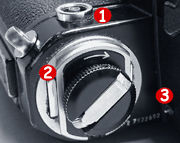Adjustments for Film Compensation
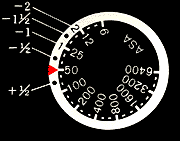 |
Some exposure correction may be necessary when certain types of films are used for copying or photomicrography applications, the amount of correction required, however, will depend on the type of film and the specific application. The following table lists the exposure corrections in f/stops required for various film/shooting requirements. Compensation is possible by adjusting the shutter speed or the aperture by the indicated amount; also, compensation is possible by adjusting the ASA film-speed index ring. |
In the example shown, the index ring is set so that the red mark is aligned with ASA 50; this setting is the correct position to achieve a one-stop increase in exposure (three scale graduations equal one stop) as required when performing photomicrography (see table) using ASA 100 Panchromatic film.
|
Original/Type of Film |
Repro/Slide Copying |
|||
|
B/W/Color |
Letters/Figures on Light Background |
Letters/Figures on Dark Background |
Photomicrography |
|
|
Panchromatic Film for general use |
No Compensation required |
+ 1-1/2 Stop |
- 1/2 Stop |
+ 1 Stop |
MULTIPLE
EXPOSURES
Intentional multiple exposures for creative effects can be made with the Nikon F2A
Photomic camera. To take a multiple exposure, perform the following:
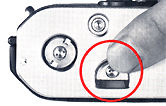 |
Make the initial exposure, depress and hold the rewind button on the camera's base plate, and stroke the film-advance lever to cock the shutter for the next exposure on the same frame; for each additional exposure on the frame, repeat the same procedure. |
At the completion of multiple
exposure operation, stroke the film-advance lever once more to release the rewind
button, cover the lens and make one blank exposure, and then resume normal operation.
Note that during multiple exposure operation, the camera's shutter speed can be changed
to any setting for the desired shooting effect. Also, throughout the multiple exposure
operation, the camera's frame counter will remain at the same setting as long as
the rewind button is held depressed while stroking the film advance lever.
MIRROR LOCKUP
The reflex mirror must be locked up when using either the Fisheye-Nikkor 6mm f/5.6
or the OP Fisheye-Nikkor 10mm f/5.6 lenses, since their rear elements protrude into
the camera body and interfere with mirror movement.
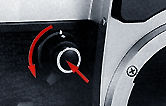 |
Locking-up the mirror is also necessary when shooting with a motor drive unit at its top speed setting. To lock up the mirror, depress and hold the depth-of-field button and turn the mirror Lock-up lever downward until the white dot is aligned with the white index line. The mirror will remain in the up position until the lever is returned to the normal position. |
FLASH SYNCHRONIZATION
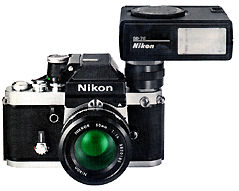 |
The Nikon F2A Photomic camera is designed to synchronize with most types of flashbulbs at almost all shutter speeds and with electronic flash at speeds to 1/80 second. The table below shows which shutter speeds may be used with different types of flashbulbs. |
|
No special adapters are necessary when using Nikon F2A Photomic camera with Nikon Flash Unit BC-7, or with the Speedlight Unit SB-7E and SB-5. |
||||||||||||||||||||||||||||||||||||||||||||||||||||||||||||||||||||||||||||||||||||||||||
1) PC sync for cabled flash
or multiple flash setup in AUTO/MANUAL mode; 2) F2 dedicated accessory shoe for specific
flash units designed for F2 OR standard ISO-type flash via flash
coupler AS-1; 3) Flash ready light contact.
Caution: When the reflex mirror is locked
in the up position, the shutter will not synchronize with flashbulbs at speeds faster
than 1/80 second.
READY- LIGHT (Check the SF-1 Readylight Attachment)
The camera's Photomic finder has a ready-light built in for use with Nikon Speedlight Units. This unique feature provides for greater ease of operation during flash photography, as the photographer need not remove his eye from the eyepiece to check if the Speedlight unit is ready for the next exposure
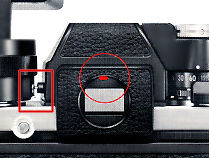 |
This built-in lamp lets the photographer know the condition of the flash (either "ready" when on, or "not ready" when off) at all times even while viewing. (For additional information, see the instruction manual supplied with the Speedlight.) |
TIPS ON CAMERA CARE
Good camera care is primarily commonsense care. Treat your Nikon F2A Photomic camera as you would any other precision optical instrument and it will provide you years of trouble-free service. Although ruggedly constructed, your camera may be damaged by shock, heat, water or misuse. By observing the following tips, you will be assured of the longest possible service life.
• Fingerprints or dust on lens/prism surfaces will make viewing uncomfortable, and will generally contribute to a deterioration of optical performance. Clean lens surfaces often using a quality lens tissue or a soft lens brush; stubborn smudges should be wiped with lens tissue moistened with methyl alcohol or a quality lens cleaner. Never clean lens surfaces using cloth, paper towels, ordinary tissue, or any other material that might scratch the lens surface; also, use cleaning fluids sparingly to prevent seepage, and resulting damage to mechanical components.
• When interchanging lenses, finders, etc., your camera is susceptible to the entry of dust or other contaminants. It is a good idea to clean moving body parts frequently to prevent the built-up of dust; here, a lens brush and blower will come in very handy. When blowing out the interior of the camera, however, avoid contact with the shutter curtains, as they are easily damaged. Also, wipe the outer body surfaces using a silicone-impregnated cleaning cloth to remove fingerprints, etc. quickly and easily. (Note that a silicone impregnated cleaning cloth should never be used to clean the lens. surfaces.)
• When exposed to sudden temperature changes or high humidity, condensation may form on the lens surfaces. After using in these situations, always dry the camera thoroughly (and slowly) at room temperature and, then, store in a cool, dry location. Remember that failure to dry out the camera may result in the growth of fungus on lens surfaces - a condition that will render your camera useless.
• Should your camera be accidentally dropped on the floor or in water, take it to your dealer immediately for servicing. Thorough servicing can be guaranteed only at an authorized dealer.
• Always store the camera in an ever-ready case or compartment case when not in use. And be sure that the lens cap is attached to the lens. Do not leave film in the camera for a long period of time, and never store the camera with the shutter or self-timer cocked.
• Never lubricate any part of the camera. Lubrication should be left to an authorized service center. Prior to a holiday trip or important shooting assignment, test your camera (including changing batteries, if necessary) for proper operation.
• 0bserve normal battery handling procedures for maximum performance at all times. Be sure to: Clean batteries periodically (wiping with a rough cloth will remove residues that might otherwise impede performance); install batteries properly, checking for proper polarity; remove batteries when not using the equipment for an extended period; change weak batteries promptly to prevent leakage within the camera; store unused batteries properly (in a cool, dry location) to maximize service life; dispose of batteries properly (do not burn); and keep out of the reach of children. For details regarding battery performance, refer to the original manufacturer.
| Previous | NEXT | 7 / 9 Lens and Prism Changing, Accessories and technical Specifications
| Back | Index Page - Nikon F2A Photomic
| Message Board | for
your favourite Nikon
F2 Series SLR model(s)
| Message Board | for your Nikon Optics in a shared environment
| Message Board | Specifically for Dispose or Looking for Nikon/Nikkor Photographic
Equipment
| Back |
to Main
Index Page of Nikon
F2 Series SLR models
| Back | Main Index Page of
Pictorial History of Nikon SLRs
 |
The Eyes of Nikon:- |
Fisheye-Nikkor Lenses - Circular | Full Frame | Ultrawides Lenses - 13mm15mm18mm20mm | Wideangle Lenses - 24mm28mm35mm |
Standard Lenses - 45mm 50mm 58mm | Telephoto Lenses - 85mm105mm135mm180mm & 200mm |
Super-Telephoto Lenses - 300mm 400mm 500mm 600mm 800mm 1200mm |
Special Application lenses:
Micro-Nikkor Lenses - 50mm~55mm -60mm 85mm -105mm 200mm Micro-Zoom 70-180mm
Perspective Control (PC) - 28mm 35mm PC-Micro 85mm
Dedicated Lenses for Nikon F3AF: AF 80mm f/2.8 | AF 200mm f/3.5 EDIF
Depth of Field Control (DC): 105mm 135mm
Medical Nikkor: 120mm 200mm
Reflex-Nikkor Lenses - 500mm 1000mm 2000mm
Others: Noct Nikkor | OP-Nikkor | UV Nikkor 55mm 105mm | Focusing Units | Bellows-Nikkor 105mm 135mm
Nikon Series E Lenses: 28mm35mm50mm100mm135mm | E-Series Zoom lenses: 36~72mm75~150mm70~210mm
MF Zoom-Nikkor Lenses: 25~50mm | 28~45mm | 28~50mm | 28~85mm | 35~70mm | 36~72mm E | 35~85mm | 35~105mm | 35~135mm |
35~200mm | 43~86mm | 50~135mm | 50~300mm | 70~210mm E | 75~150mm E | 80~200mm | 85~250mm |
100~300mm | 180~600mm | 200~400mm | 200~600mm | 360~1200mm | 1200~1700mm
Tele-Converters: TC-1 | TC-2 | TC-200 | TC-201 | TC-300 | TC-301 | TC-14 | TC-14A | TC-14B | TC-14C | TC-14E | TC-16 | TC-16A | TC-20E
![]()
Nikon F
| Nikon F2 |
Nikon
F3
| Nikon F4 |
Nikon
F5
| Nikon F6 |
Nikkormat / Nikomat |
Nikon FM
| Nikon FE/ FA | Nikon EM/FG/FG20 | Nikon Digital SLRs | Nikon - Other models
MIR Supports for Photographic Community: Various Message Boards/Community
Forums
Nikon
F-series|
Nikon
F2-series|
Nikon
F3-series|
Nikon F4-series| Nikon
F5-series|Nikkormat/Nikomat-series
Nikon FM-series|Nikon
FE-series|Nikon
FA|Nikon
Digital
SLR
series|Various
Nikon
Models|Nikkor
Optic
-shared
Others:- Free Trade Zone - Photography| Free Trade Zone - Business Community |Free To Zouk - Photographic Community
Apple's Mac Public Community Message Board | Windows based PC &
Apple/Mac
Public Community Trade Exchange Centre
Recommended links to understand
more technical details related to the Nikkor F-mount and production Serial Number:
http://rick_oleson.tripod.com/index-153.html by: my friend, Rick Oleson
http://www.zi.ku.dk/personal/lhhansen/photo/fmount.htm by: Hansen, Lars Holst
http://www.mir.com.my/rb/photography/hardwares/nikonfmount/lens2.htm
http://www.photosynthesis.co.nz/nikon/serialno.html
About this photographic site.
HOME - Photography in Malaysia |
Copyright © 2000. leofoo ®. MIR Web Development Team.
In
memory of my friend Com.
Augusto Staut,
Brazil, 1971-2000.
Credit: Chuck Hester, US for his patience, encouragement
and help to setup the various content in this site; Robert Johnson for some of his original
images on the F2H-MD appeared in this site; my ex-staff, KiaSu for his superb
3-D logo appeared in this Nikon F2 site; Marc Vorgers from Holland who
generously provide me with some of his images of F2AS; MCLau®, who has so much time with me to
re-edit the content in this site and not to mention buying a Nikon Coolpix 990 just
for this site. Keat Photo,
Kuala Lumpur for providing
their Nikon F2A to take some images for this site; again, Mr Edward Ngoh the
great camera collector who provides us his collection of F2AS with MD-2; hawkeye.photographic.com
for their images on the Speed Magny film backs; Sean Cranor for his image
on Nikon F2 25th Anniversary Model; Ted Wengelaar®, Holland for his continuous
flow of input on some of the early Nikon bodies; CYLeow ® , photo editor of the Star
newspaper, Malaysia for some of his images used in this site. Ms Rissa Chan, Sales manager from
Shriro Malaysia who has helped to provide some of the very useful input. HiuraShinsaku®,
Nikomat ML, Japan for some of his images on various F2 models; my staff, Wati, Maisa, Mai and my nephew, EEWyn®, who volunteered and helping me
did so many of the film scanning works. Contributing photographers or resellers:
Jen Siow, Foo KokKin, Arthur Teng, Mark Fallander, John
Ishii, Ed Hassel, YoonKi Kim, Jean-Louis, M.Dugentas (Dell Corner.com.), Mr "Arsenall" and a few images mailed
in from surfers with no appropriate reference to their origin. Dedicated to KU Yeo, just to express our mutual regrets over the outcome of
a recent corporate event. Made with a PowerMac, broadcast with a Redhat Linux powered server.
![]()
![]()
